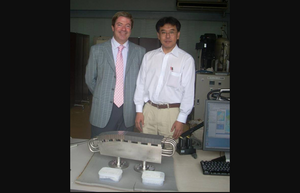Japanese divertor qualification prototype succeeds performance tests
Prior to starting the construction of the divertor plasma-facing components, each Domestic Agency concerned must first "qualify" by demonstrating its technical capability to carry out the procurement with the required quality, and in a timely manner. This is achieved via the successful manufacturing of medium-size qualification prototypes, which are then subject to high heat flux performance tests in the electron beam facility "Tsefey-M" located at the Efremov Institute in St. Petersburg, Russia. The qualification prototypes are about half a metre long, and include all the most technically challenging features of the corresponding ITER divertor design.
The Japanese Domestic Agency has been allocated the procurement of the outer vertical target component of the ITER divertor, which is the in-vessel component subject to the highest heat load. It consists of a lower straight section, protected by carbon monoblocks, an upper curved section with tungsten monoblocks, and a steel support structure.
As planned, the Japanese prototype completed its performance tests in November 2008, after 1,000 cycles at 3 MW/m² and 1,000 cycles at 5 MW/m² on the tungsten armoured region, plus 1,000 cycles at 10 MW/m² and 1,000 cycles at 20 MW/m² on the carbon region. This latter result represents a number of cycles that is more than three times higher than the design target of 300 cycles.
In a letter to his Japanese counterpart Satoshi Suzuki, the ITER Divertor Section Leader, Mario Merola, congratulated Suzuki and his team, as well as the industry involved, "for this important achievement and for the dedicated effort which was instrumental in making this goal a reality." "This is a very important accomplishment for the project," remarked Gary Johnson, ITER Deputy Director-General responsible for the Tokamak Department.
The comment of Masato Akiba, head of the Division of Fusion Energy Technology at the Japanese Atomic Energy Agency (JAEA), was particularly touching. "From the bottom of my heart, as former group leader of the ITER divertor at JAEA, I would like to express my deep appreciation to all the concerned ITER colleagues as well as the colleagues from Russia. I believe that we, the ITER Organization and all parties, are an excellent team, and today's success has been achieved by the results of this 'team,' not only by the Japanese Domestic Agency."
The start of the construction of the ITER divertor is planned early next year and is due to be completed in 2016.


